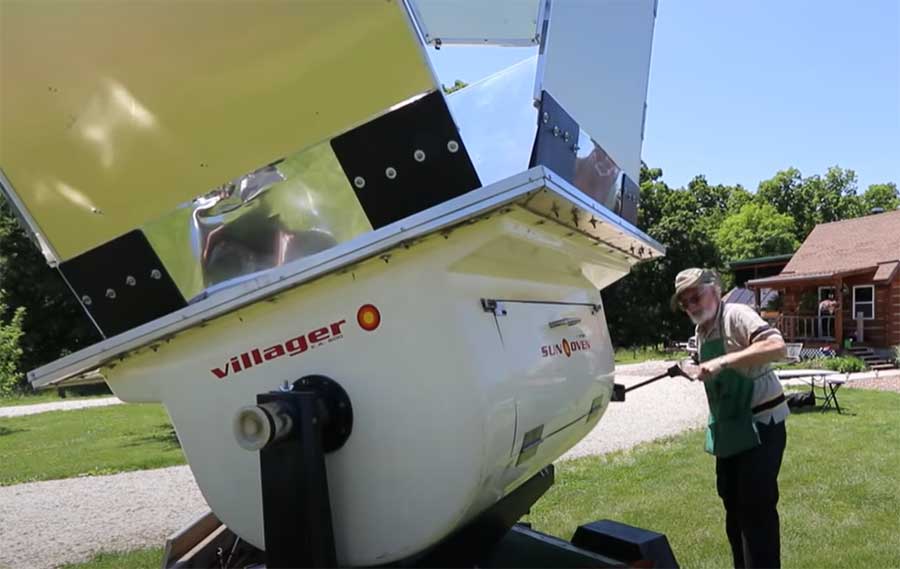
Feed the World Effectively
The Villager Sun Oven can bake over 200 loaves of bread in 8 hours. It can feed over a thousand people a day. And what can it cook? Nearly anything. From perfect fluffy rice to large pots of rustic stews, the Sun Oven is endlessly adaptable to all cuisines and ingredients, as has been proven in over 55 countries.
How the Villager Works
Cooking for a crowd with electricity or fuel is a big hurdle for humanitarian missions. The Villager Sun Oven solves that problem — not just on sunny days, but 24/7.
That’s because the world’s largest solar cooker is also an incredibly efficient propane oven.
- With sunshine alone, the Villager Sun Oven is capable of baking over 28 loaves of bread per hour.
- It cooks up to 1,200 meals a day.
- Without gadgets or electronics, it reaches and sustains 500 degrees Fahrenheit for hours with just sunlight.
The Villager Sun Oven is so effective that communities continue using them for years, even decades. But the Villager Sun Ovens are also made to travel.

Powered by Sunlight During the Day
If used in daylight, on a sunny day, there are no expenses for running a Villager Sun Oven. It’s ideal for communal living, disaster relief, refugee camps, and anywhere the power grid is unreliable.
But disaster relief and refugee crises are 24/7 affairs, and that’s why the Villager Sun Oven works around the clock too, if needed, with propane.
Powered by Propane at Night
In under two minutes, one person can convert the Sun Oven into a highly-efficient propane-powered oven that cooks for eight hours on just over a pound of propane. At dawn, converting it back to a solar cooker takes just another two minutes to get back to emissions-free cooking.
How the Villager Sun Oven Works
When it’s sunny out, the oven deploys in as little as 5 to 10 minutes. Park it where there’s all-day uninterrupted sunshine, check the focus indicator, and set the angle of the Sun Oven.
Now, “focus indicator” may sound high tech, but it involves just looking in a hole to see if the sunbeam focused is in the middle – if it is, the solar cooker is aimed the right way. If not, move it until the sunbeam is a sharp bright dot. Positioning the oven is that simple.
Next, the panels need unfolding, which may require a step stool for vertically-challenged folks, but no tools or big muscles are necessary. Once the panels are positioned, just wait till the oven thermometers say it’s hot enough to cook — and that won’t take long.
Cooking is simple too — just put prepared foods onto the oven’s shelf to cook. Most meals cook in under two hours. It’s low-maintenance cooking, but it’s also much, much harder to burn food in a solar cooker. It’s ideal in busy environments where large crowds dictate that time is better spent on food prep rather than stirring a pot on a burner.
Despite sustaining a 500-degree-Fahrenheit interior, the Villager Sun Ovens’ fiberglass exterior shell is heavily insulated, which keeps the outside safe and cool for high-traffic areas. (It’s also why it’s so efficient with propane.)
As the sun transits across the sky, the oven needs rotating every hour or so to keep cooking at maximum temperature. Again, this isn’t grunt work, as one person can easily spin the oven 360 degrees on its trailer mount to line up with the sun.

Anyone Can Use It
With no gauges, meters, or moving parts, there are no language barriers or complexities limiting who can operate the Villager Sun Oven. It needs no specially-trained cooks.
It also doesn’t need specialized or expensive cookware. The most effective cookware is common, budget-friendly, everyday granite enamelware, since it’s thin and dark, for absorbing heat quickly. With these, most meals can cook in under two hours.
The lack of moving parts means these massive ovens need little maintenance. Clean reflector panels and clean glass are key to performance, but easily done. The only other maintenance to do is applying lubrication on the hand crank’s shaft when needed to keep cranking easy when adjusting the oven’s angle.

The Other Science of Solar Cooking
The benefits of using solar power, particularly in disaster and refugee scenarios where the power grid is damaged, are easily understood. But the other benefits of solar cooking may be less familiar.
The highly-insulated solar cooker gets extremely hot, up to 500 degrees Fahrenheit, but it does so with infrared heat after capturing and converting UV rays. The ambient temperature inside the oven is the same for the pot, what’s in the post and the air around the pot, that’s why the food inside the oven doesn’t burn, dry out or need continual stirring.
There’s another perk to not using direct heat in solar cooking: Meals cook with less liquid, often with no liquid needed at all. It’s why the Sun Oven is ideal in areas where safe, abundant water is hard to come by. In fact, the Villager Sun Oven can pasteurize large quantities of unsafe water making it fit for consumption.
